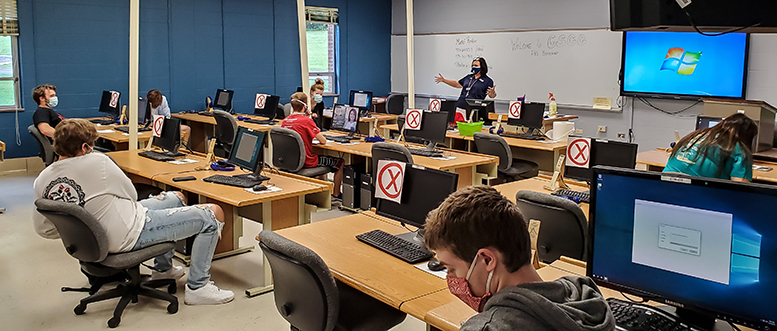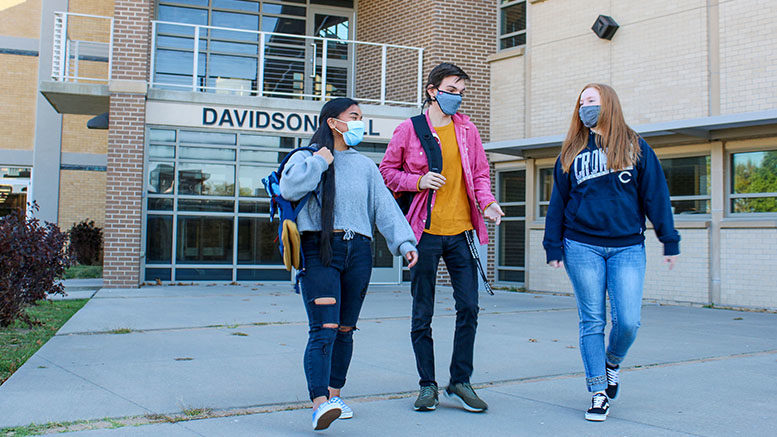With states all dealing with the coronavirus differently, it’s no surprise that community colleges have a wide variety of strategies for reopening. They range from Crowder College in Neosho, Missouri, open since last fall, to Portland Community College in Oregon, which currently has a very small number of in-person classes and does not plan a full reopening in the fall.
Everyone is looking at the same health guidance from the Centers for Disease Control and Prevention, but in some cases state guidance is more lenient. States have different priorities for how quickly college faculty can be vaccinated. All colleges have the same goal: to get back as soon as possible to a relatively normal campus life. And everyone wants to reverse the decline in student enrollment, which among those interviewed ranged from 4% (Crowder) to 18% (Portland).
In this piece, we look at the plans of three community colleges that are opening to more in-person classes. In Part 2, we will look at three colleges with a more cautious approach. Location is of course a factor.
Open since fall 2020
“Our students rely a lot on our campus for assistance with their educational program,” said Crowder College President Glenn Coltharp. Many Crowder students are on TRIO, federal programs that help students from disadvantaged backgrounds.
“During the shutdown last spring, we did a good job connecting with students, but it wasn’t the same when it wasn’t face-to-face,” Coltharp said. The college started to offer some face-to-face services in the summer, but not classes.
One service that reopened in the summer was the computer labs. The administration had learned during the spring shutdown how essential those are to students.
“Our region is very rural,” Coltharp said. “The internet is always a challenge. We moved wi-fi to the parking lots, but not everyone had the technology to work out there. Some students didn’t have a computer. They were trying to do their classwork on their phone.”
The Crowder campus has been open since last fall for its 3,000 students. Most professors and staff have returned to campus, but a lot of meetings are remote. Some staff have modified their work schedules so that they are not in their office at the same time as others in close proximity.
Students can choose to take all-online classes, and 20 percent have done so – about twice as many as before the pandemic. Those on campus are encouraged but not required to wear masks.
“We’re getting good support with mask-wearing,” Coltharp said. “We’ll see after the vaccinations. We’ll keep some modifications and may be able to pull back on others.”
College educators are in the third phase of the vaccine rollout in Missouri, which Coltharp hopes will start in March.
Moving toward full fall opening
When the nationwide lockdown came last March, National Park College (NPC) in Arkansas was in better shape than some because every class already had an online presence. That had been a college policy for several years, said Wade Derden, vice president for academic affairs.
So last fall, NPC was able to move a lot of classes completely online. A few technical education and nursing classes were moved into bigger spaces so students could spread out, or class sizes were limited so everyone could be six feet apart, Derden said.
NPC added Zoom technology and a webcam to every space last fall. That worked out well because “as the semester progressed and case numbers worsened, more students migrated to remote,” Derden said.
But it was hard for faculty to manage classes where some students were physically present and others were on Zoom. So this spring, some classes are completely on Zoom, some – about 25 percent – are face-to-face, others are completely online for students to do at their own pace, and others are blended.
For the blended classes, some class meetings are face-to-face and others are virtual, for students to do on their own. That’s useful for computer science classes, where students come to campus to learn the elements of the class, then complete the rest at home on their own time.
For the future, “we’re being optimistic and planning a normal fall semester,” Derden said. “We’re going to keep offering Zoom-only instruction. Only 5% to 7% of students enrolled in that, but they like it.”
For in-person classes, classrooms are still restricted in size. For those who come on campus, cloth face coverings are required unless people are outside and six feet apart, and everyone needs to complete a questionnaire and have their temperature checked. Student compliance with mask requirements is generally good, Derden said.
In Arkansas, educators of all levels will be eligible for a Covid vaccine February 24 – “assuming there are doses available,” Derden said.
He feels fortunate the college has seen only a 9% decrease in enrollment, after budgeting for a 12% drop. The college is in a resort town, Hot Springs National Park, that sees more than 3 million visitors a year. So administrators were careful not to reopen too quickly.
More in-person classes this fall
Cleveland State Community College in Tennessee currently has a mix of classes: about 15% in-person, 25% fully online and 60% hybrid. That breakdown is similar to last fall, said President Bill Seymour.
One change this semester: There are more seven-week classes. They offer the same credit hours and cover the same material, but in a condensed format. They filled up quickly.
“That was already part of our strategic plan, and we want to continue that in the future,” Seymour said.
The college is developing contingency plans for the summer and fall since the timing of the vaccine rollout is still unclear. Most summer classes will likely be online.
In the fall, “I’m hoping we get to more of a balance, 50% on-the-ground, 50% hybrid and online,” Seymour said. “We’ll move up and down, if necessary.”
To come on campus, every student and employee must go through a check-in process. Masks are required at all times.
The class schedule has been changed to allow an hour for cleaning between classes, so classes might be offered at 8 a.m., 10 a.m. and 12 p.m.
“It’s difficult to do, but it’s important before vaccine rollout,” Seymour said. “I think we could do without that in the fall.”
In-person classes are smaller to ensure social distancing. A class might be scheduled in two sections on different days.
The college has struggled with enrollment and retention, which the administration anticipated. Enrollment fell 9% in the fall and was down 13% in the spring from last spring.

Part of the problem: “It’s difficult to get into high schools to talk about dual enrollment,” Seymour said. Dual enrollment high school students usually comprise 25% to 30% of the student body.
For the rest, a large proportion of the students are adults, many with full-time jobs and families.
“With the difficulties that come with the pandemic, a larger number of our students decided, ‘I can’t go next semester,’” Seymour said.
Then again, “some people are just fearful of engaging in any type of activity now,” he said. “And a certain percentage of people are fearful of online learning.”
As it is everywhere, vaccine rollout in the five counties the college serves is slow. In Tennessee, K-12 educators will get vaccinated before college faculty.
“I think it’s short-sighted,” Seymour said.

